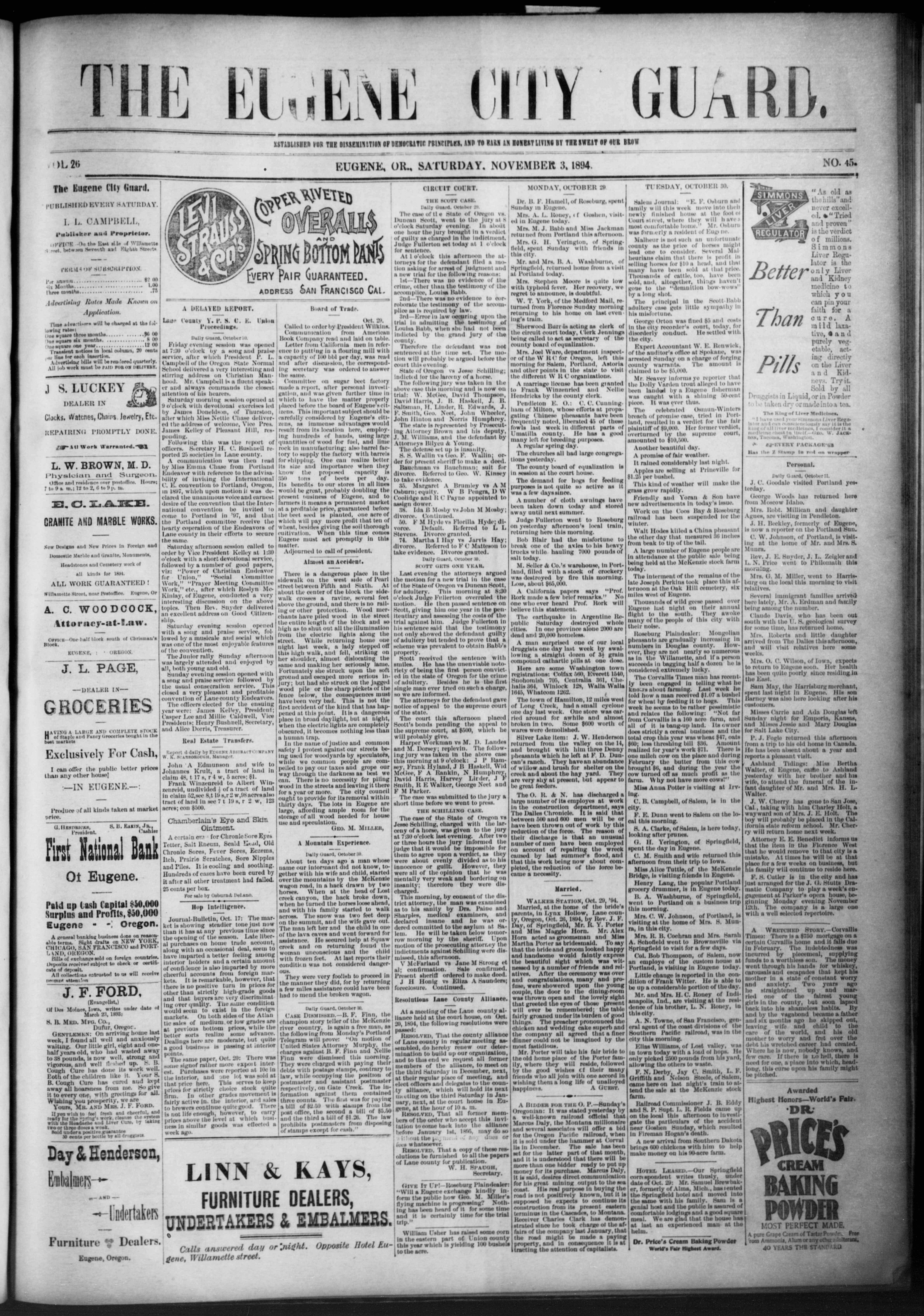|
Crawfordsville, Oregon
Crawfordsville is a census-designated place and unincorporated community in Linn County, Oregon, United States. As of the 2010 census it had a population of 332. It is located about southeast of Brownsville and southwest of Sweet Home on Oregon Route 228, near the Calapooia River. It has a post office with a ZIP code of 97336. Demographics History Crawfordsville was founded on the land of Philemon Vawter Crawford in 1870 by Crawford and Robert Glass. When the post office was established in 1870, it was named for Crawford. Crawford was born in Madison, Indiana, in 1814 and he arrived in Oregon via the Oregon Trail in 1851. His son, Jasper V. Crawford, was the first postmaster. Philemon Crawford had previously helped establish the Boston Flour Mill near Shedd. In 1915 Crawfordsville had a population of 300, two sawmills, a flouring mill, a high school, an elementary school, and three churches. In the early 20th century, Crawfordsville had a population of Sikhs from Pa ... [...More Info...] [...Related Items...] OR: [Wikipedia] [Google] [Baidu] |
Census-designated Place
A census-designated place (CDP) is a concentration of population defined by the United States Census Bureau for statistical purposes only. CDPs have been used in each decennial census since 1980 as the counterparts of incorporated places, such as self-governing cities, towns, and villages, for the purposes of gathering and correlating statistical data. CDPs are populated areas that generally include one officially designated but currently unincorporated community, for which the CDP is named, plus surrounding inhabited countryside of varying dimensions and, occasionally, other, smaller unincorporated communities as well. CDPs include small rural communities, edge cities, colonias located along the Mexico–United States border, and unincorporated resort and retirement communities and their environs. The boundaries of any CDP may change from decade to decade, and the Census Bureau may de-establish a CDP after a period of study, then re-establish it some decades later. Mo ... [...More Info...] [...Related Items...] OR: [Wikipedia] [Google] [Baidu] |
Calapooia River
The Calapooia River is an tributary of the Willamette River in the U.S. state of Oregon. The Calapooia flows generally northwest from its source in the Cascade Range near Tidbits Mountain. In its upper reaches, it passes through parts of the Willamette National Forest. Further downstream, it flows through Holley then Crawfordsville and Brownsville in the Willamette Valley before joining the Willamette at Albany. The city of Tangent is also near the river on a branch of one of its downstream tributaries, Lake Creek. The confluence of the two rivers is about by water from where the Willamette joins the Columbia River The map includes mile markers along the Calapooia and Willamette rivers. The Calapooia was named for the Kalapuya (also spelled Calapooia), a tribe of Native Americans. Tributaries Named tributaries of the river from source to mouth are Eighteen, Treadwell, and United States creeks followed by the North Fork Calapooia River. Then come King, Potts, Barrett/Han ... [...More Info...] [...Related Items...] OR: [Wikipedia] [Google] [Baidu] |
The Register-Guard
''The Register-Guard'' is a daily newspaper in the northwestern United States, published in Eugene, Oregon. It was formed in a 1930 merger of two Eugene papers, the ''Eugene Daily Guard'' and the ''Morning Register''. The paper serves the Eugene- Springfield area, as well as the Oregon Coast, Umpqua River valley, and surrounding areas. As of 2016, it has a circulation of around 43,000 Monday through Friday, around 47,000 on Saturday, and a little under 50,000 on Sunday. The newspaper has been owned by The Gannett Company since Gannett's 2019 merger with GateHouse Media. It had been sold to GateHouse in 2018. From 1927 to 2018, it was owned by the Baker family of Eugene, and members of the family served as both editor and publisher for nearly all of that time period. It is Oregon's second-largest daily newspaper and, until its 2018 sale to GateHouse, was one of the few medium-sized family newspapers left in the United States. History of ''The Guard'' Establishment ''The Guard ... [...More Info...] [...Related Items...] OR: [Wikipedia] [Google] [Baidu] |
Sweet Home School District
The Sweet Home School District (#55) is a public school district serving Sweet Home, Oregon, United States and the surrounding communities of Crawfordsville, Holley, Cascadia, and Liberty, and the Pleasant Valley area. History Early history The district was incorporated on December 20, 1964 following a recommendation from the Linn County reorganization committee that the Crawfordsville, Holley, Cascadia, Liberty, Foster, Sweet Home Elementary and Sweet Home Union High School districts be consolidated into one administrative district. Prior to consolidation, Sweet Home Union High School's history dates back to 1912. Modern history In 1990, the district was the largest recipient in the state of tax revenues from private timber harvest. In 2011, The Center for American Progress recognized the Sweet Home School District for receiving the organization's highest Return on Investment score in a nationwide study comparing student achievement relative to available funding. Sweet ... [...More Info...] [...Related Items...] OR: [Wikipedia] [Google] [Baidu] |
Sikh
Sikhs ( or ; pa, ਸਿੱਖ, ' ) are people who adhere to Sikhism (Sikhi), a monotheistic religion that originated in the late 15th century in the Punjab region of the Indian subcontinent, based on the revelation of Guru Nanak. The term ''Sikh'' has its origin in the word ' (), meaning 'disciple' or 'student'. Male Sikhs generally have ''Singh'' ('lion'/'tiger') as their last name, though not all Singhs are necessarily Sikhs; likewise, female Sikhs have ''Kaur'' ('princess') as their last name. These unique last names were given by the Gurus to allow Sikhs to stand out and also as an act of defiance to India's caste system, which the Gurus were always against. Sikhs strongly believe in the idea of "Sarbat Da Bhala" - "Welfare of all" and are often seen on the frontline to provide humanitarian aid across the world. Sikhs who have undergone the '' Amrit Sanchar'' ('baptism by Khanda'), an initiation ceremony, are from the day of their initiation known as Khalsa, and they mu ... [...More Info...] [...Related Items...] OR: [Wikipedia] [Google] [Baidu] |
Caxton Press (United States)
Caxton Press (formerly known as Caxton Printers, a division of its parent company, The Caxton Printers Ltd.) is a book publisher located in Caldwell, Idaho, United States, founded in 1925. It is also a distributor of books from the University of Idaho Press, Black Canyon Communications, Snake Country Publishing, Historic Idaho Series and Alpha Omega Publishing. It was founded by J. H. Gipson to give western writers, particularly of non-fiction about the people or culture of the Western United States The Western United States (also called the American West, the Far West, and the West) is the region comprising the westernmost states of the United States. As American settlement in the U.S. expanded westward, the meaning of the term ''the Wes ..., a vehicle for publication of their work. History It is the publishing division of The Caxton Printers Ltd., founded in Caldwell in 1895 by A. E. Gipson, as the Gem State Rural Publishing Company, renamed to its present name in 1 ... [...More Info...] [...Related Items...] OR: [Wikipedia] [Google] [Baidu] |
Gristmill
A gristmill (also: grist mill, corn mill, flour mill, feed mill or feedmill) grinds cereal grain into flour and middlings. The term can refer to either the grinding mechanism or the building that holds it. Grist is grain that has been separated from its chaff in preparation for grinding. History Early history The Greek geographer Strabo reports in his ''Geography'' a water-powered grain-mill to have existed near the palace of king Mithradates VI Eupator at Cabira, Asia Minor, before 71 BC. The early mills had horizontal paddle wheels, an arrangement which later became known as the " Norse wheel", as many were found in Scandinavia. The paddle wheel was attached to a shaft which was, in turn, attached to the centre of the millstone called the "runner stone". The turning force produced by the water on the paddles was transferred directly to the runner stone, causing it to grind against a stationary "bed", a stone of a similar size and shape. This simple arrangement required ... [...More Info...] [...Related Items...] OR: [Wikipedia] [Google] [Baidu] |
Sawmill
A sawmill (saw mill, saw-mill) or lumber mill is a facility where logging, logs are cut into lumber. Modern sawmills use a motorized saw to cut logs lengthwise to make long pieces, and crosswise to length depending on standard or custom sizes (dimensional lumber). The Portable sawmill, "portable" sawmill is of simple operation. The log lies flat on a steel bed, and the motorized saw cuts the log horizontally along the length of the bed, by the operator manually pushing the saw. The most basic kind of sawmill consists of a chainsaw and a customized jig ("Alaskan sawmill"), with similar horizontal operation. Before the invention of the sawmill, boards were made in various manual labour, manual ways, either wood splitting, rived (split) and plane (tool), planed, hewing, hewn, or more often hand sawn by two men with a whipsaw, one above and another in a saw pit below. The earliest known mechanical mill is the Hierapolis sawmill, a Roman water-powered stone mill at Hierapolis, Asia ... [...More Info...] [...Related Items...] OR: [Wikipedia] [Google] [Baidu] |
Shedd, Oregon
Shedd is an Unincorporated area, unincorporated community and census-designated place (CDP) in Linn County, Oregon, Linn County, Oregon, United States, on Oregon Route 99E. As of the 2010 United States Census, 2010 census it had a population of 204. History In 1858, a community and gristmill was established about a mile and a half east of the present town of Shedd and called "Boston", probably because one of the founders came from Boston, Massachusetts. Boston was platted in 1861 with a New England-style town square. The town became a stagecoach stop, and "Boston Mills" post office was established in 1869. Efforts to get the Oregon and California Railroad, which was being built south from Albany, Oregon, Albany, to come through Boston Mills were unsuccessful. The railroad was instead built through the nearby land donated by Civil War veteran Captain Frank Shedd, and "Shedd's Station" was created in 1871. The post office was moved soon after. Many of Boston's buildings, though not ... [...More Info...] [...Related Items...] OR: [Wikipedia] [Google] [Baidu] |
Boston Flour Mill
Boston Flour Mill is a historic gristmill A gristmill (also: grist mill, corn mill, flour mill, feed mill or feedmill) grinds cereal grain into flour and middlings. The term can refer to either the grinding mechanism or the building that holds it. Grist is grain that has been separated ... in Shedd, Oregon. It was built in 1863 and added to the National Register of Historic Places in 1979. It is part of the Thompson's Mills State Heritage Site. The mill has been the site of field schools of both the historic preservation program and the archaeology program of the University of Oregon, in 2003 and 2005 respectively. References External linksThe Boston Mill Society [...More Info...] [...Related Items...] OR: [Wikipedia] [Google] [Baidu] |
Oregon Trail
The Oregon Trail was a east–west, large-wheeled wagon route and emigrant trail in the United States that connected the Missouri River to valleys in Oregon. The eastern part of the Oregon Trail spanned part of what is now the state of Kansas and nearly all of what are now the states of Nebraska and Wyoming. The western half of the trail spanned most of the current states of Idaho and Oregon. The Oregon Trail was laid by fur traders and trappers from about 1811 to 1840 and was only passable on foot or on horseback. By 1836, when the first migrant wagon train was organized in Independence, Missouri, a wagon trail had been cleared to Fort Hall, Idaho. Wagon trails were cleared increasingly farther west and eventually reached all the way to the Willamette Valley in Oregon, at which point what came to be called the Oregon Trail was complete, even as almost annual improvements were made in the form of bridges, cutoffs, ferries, and roads, which made the trip faster and safer ... [...More Info...] [...Related Items...] OR: [Wikipedia] [Google] [Baidu] |
Madison, Indiana
Madison is a city in and the county seat of Jefferson County, Indiana, United States, along the Ohio River. As of the 2010 United States Census its population was 11,967. Over 55,000 people live within of downtown Madison. Madison is the largest city along the Ohio River between Louisville and Cincinnati. Madison is one of the core cities of the Louisville-Elizabethtown-Madison metroplex, an area with a population of approximately 1.5 million. In 2006, the majority of Madison's downtown area was designated a National Historic Landmark—133 blocks of the downtown area is known as the Madison Historic Landmark District. Geography Madison is located at (38.750, −85.395), on the north side of the Ohio River. It is bordered to the south, across the river, by the city of Milton, Kentucky. U.S. Route 421 passes through the center of town, crossing the Ohio into Kentucky on the Milton–Madison Bridge. US-421 leads north to Versailles, Indiana, and south to Campbellsburg, Kentuck ... [...More Info...] [...Related Items...] OR: [Wikipedia] [Google] [Baidu] |







.jpg)